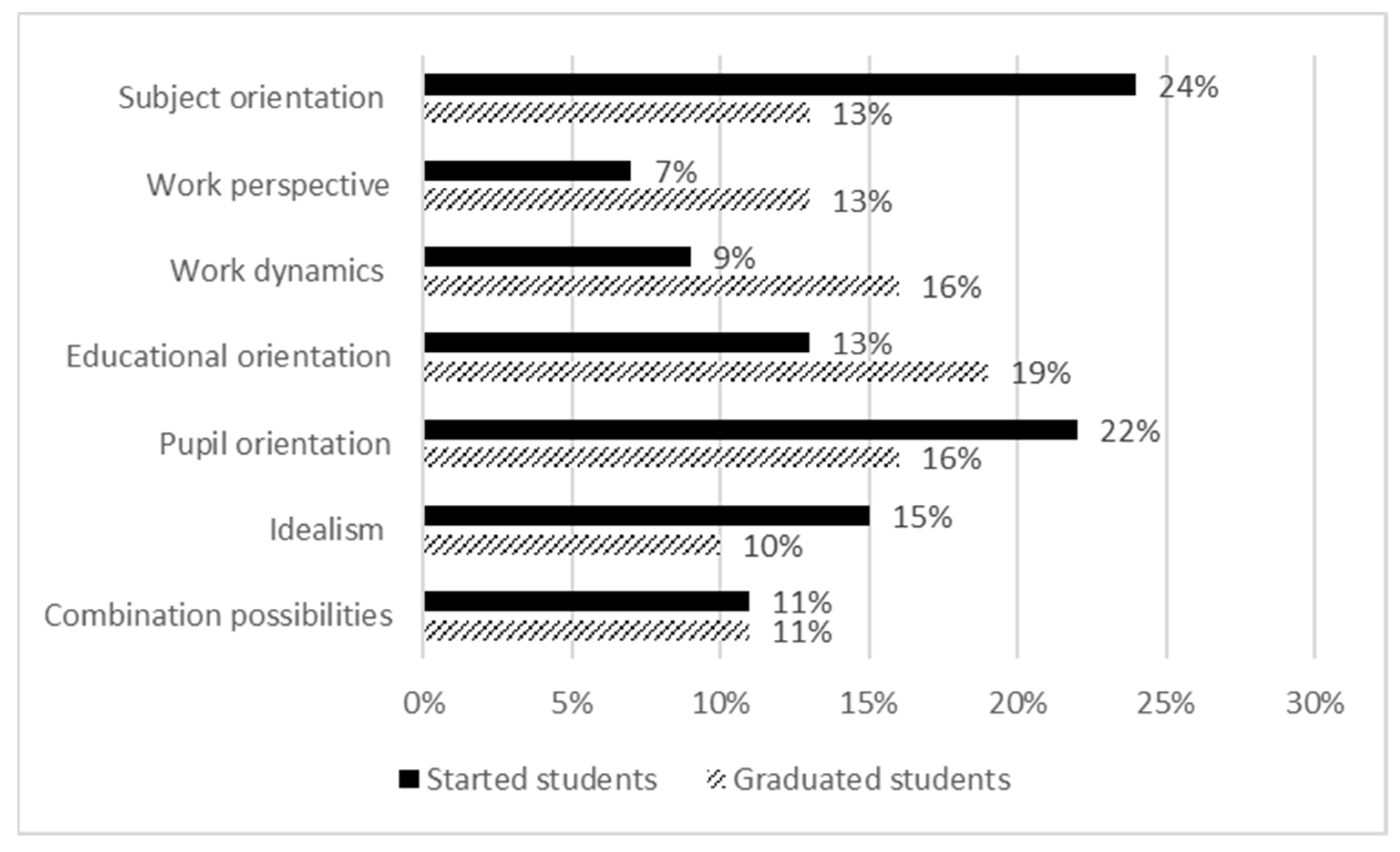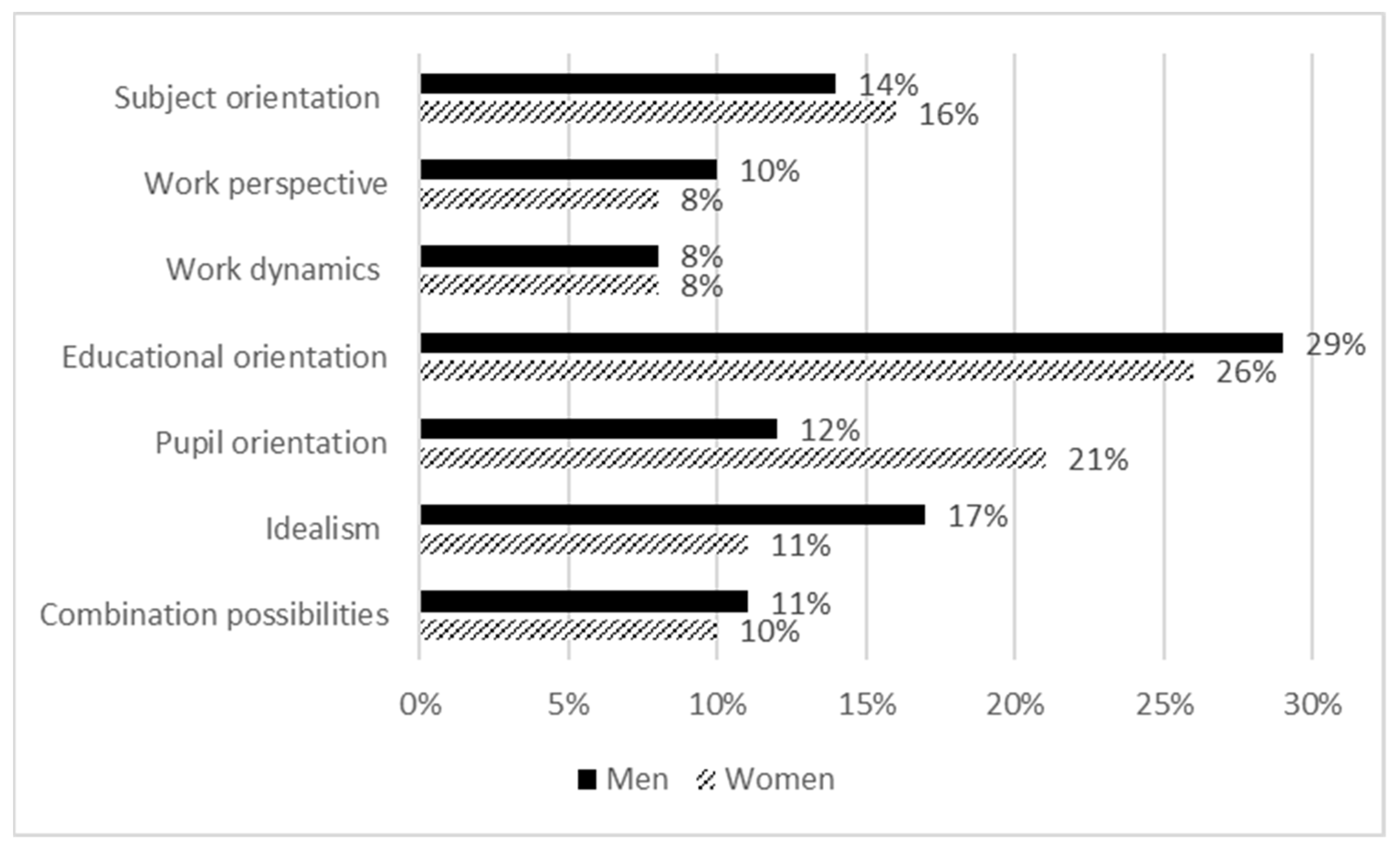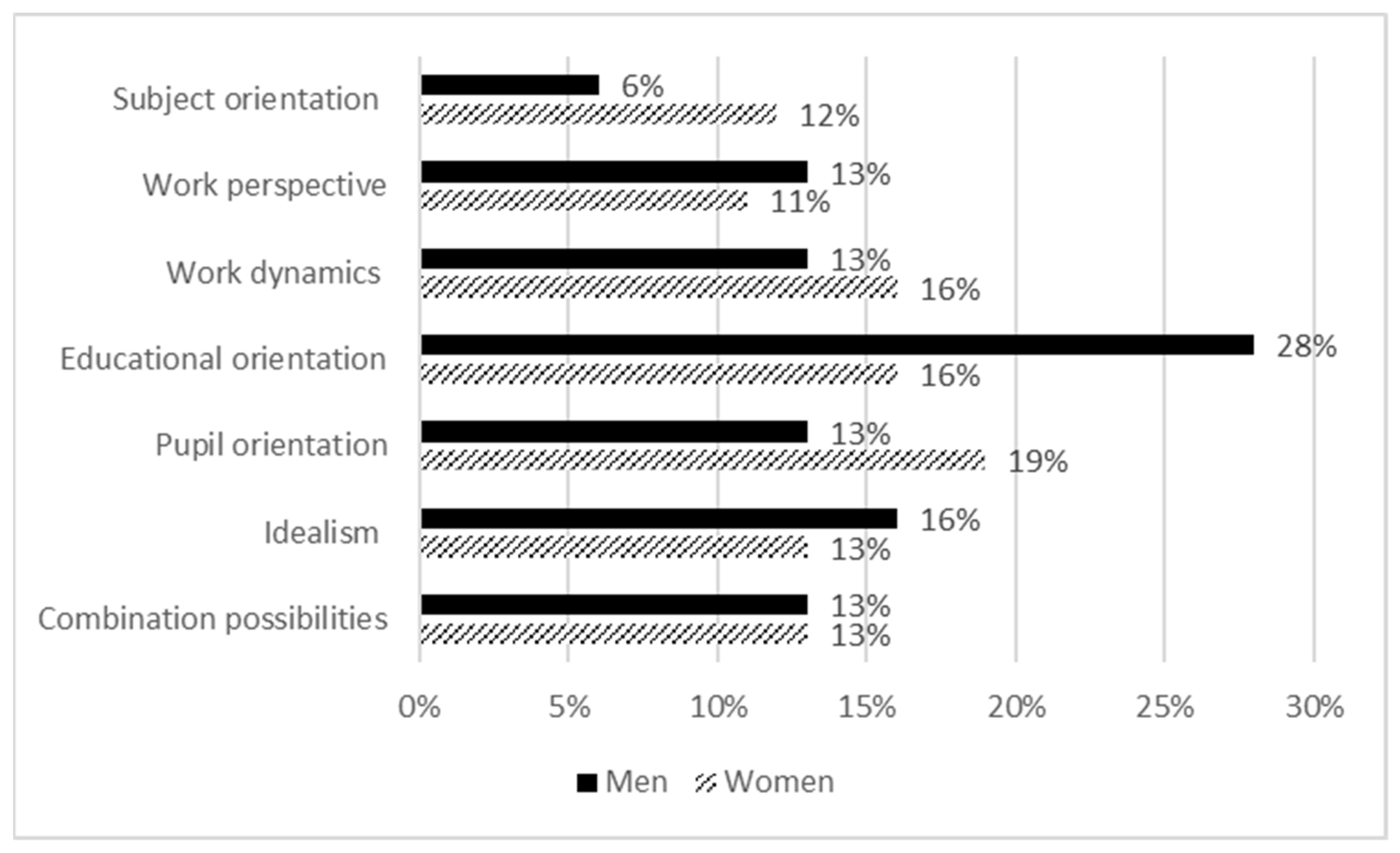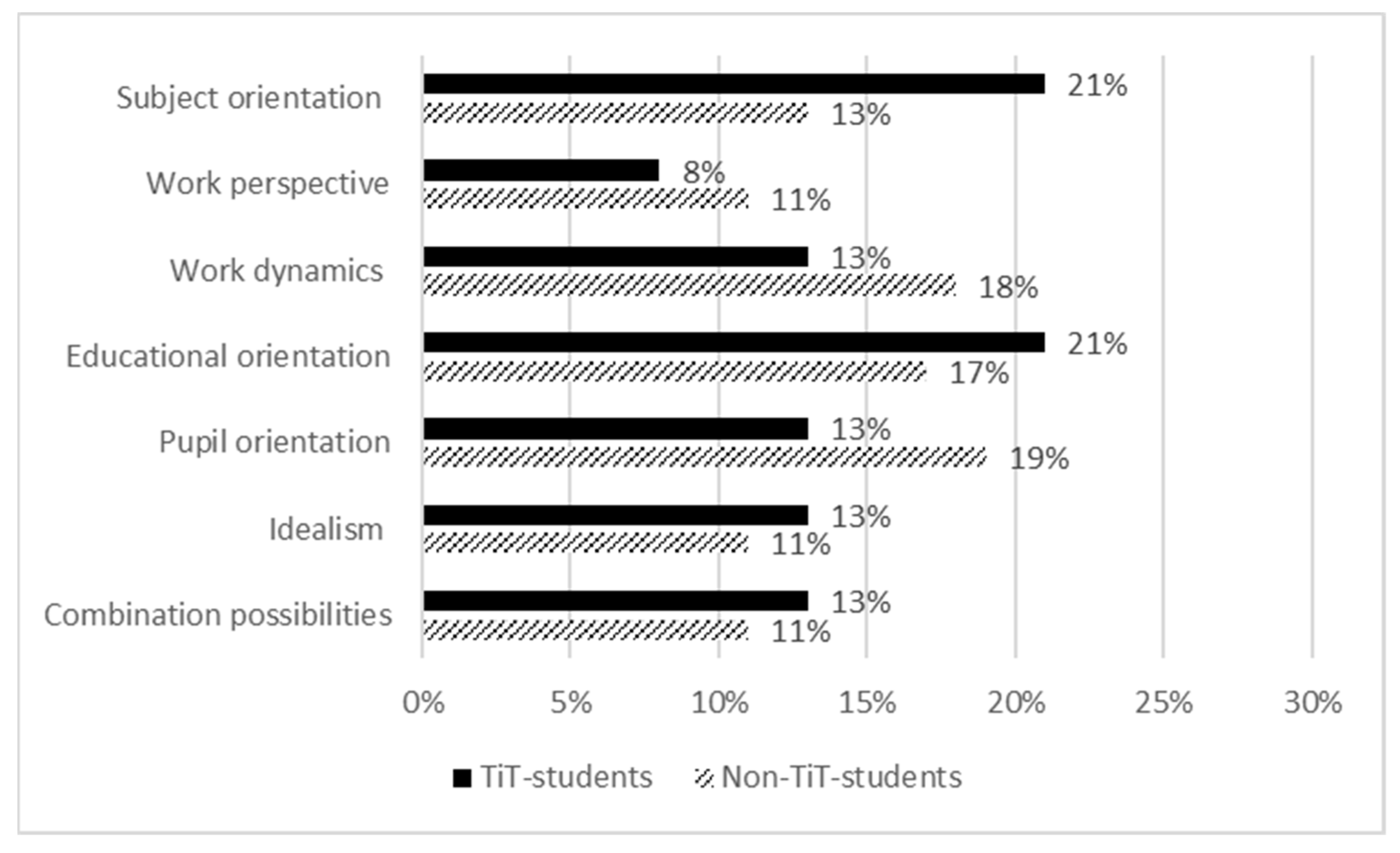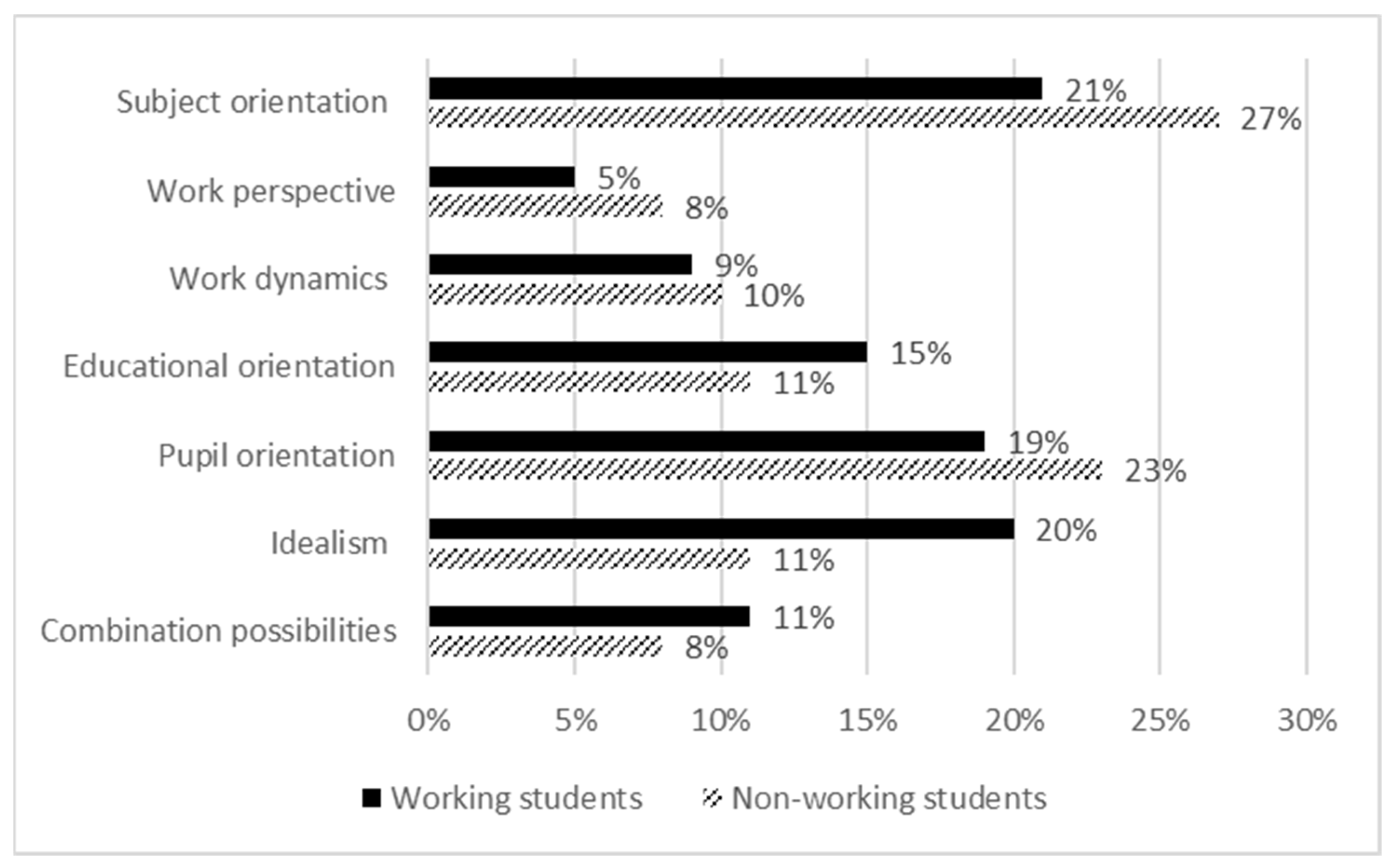1. Introduction
The popularity of teaching has been under pressure in many industrialized countries worldwide for several decades, which is also the case in Belgium, leading to a teacher shortage [
1]. The media emphasizes this social problem because school leaders do not find enough teachers [
2,
3]. Both the demand and supply side of education influence the teacher shortage. On the demand side, the rising number of pupils create a need for more teachers. A research in Flanders (part of Belgium) shows that the demand for education, for example in the age group 12–18, in the school year 2025–2026 is expected to be on average 16.8% higher than in 2015–2016 [
4]. On the supply side, the teacher shortage on the one hand is due to insufficient teacher inflow. For example, the number of enrolments for teacher education is declining [
5,
6]. On the other hand, the teacher shortage on the supply side can be explained by a large outflow of teachers. Factors such as natural outflow, high work pressure, little future perspective, emotionally and physically demanding job and flat career play a role [
7,
8,
9,
10,
11]. The first five years are crucial for beginning teachers, as they are decisive for the further development of a career in education [
12]. In Flanders up to 44% of starting teachers leave secondary education within five years [
13].
Research into the motives of student teachers to become and remain teachers is an added value to gain in-depth insights into the teacher shortage [
12]. The present study uses data from surveys on the motives of student teachers at the University of Antwerp (Belgium). The corresponding general research question is: What motivates student teachers to become teachers (within the teacher education program of the University of Antwerp)? An important development that is occurring in teacher education, in Flanders but also in many other countries worldwide where there is a clear teacher shortage, is that more and more students are combining teacher education with actual teaching [
14,
15]. The practical component of the training is then fully implemented as a teacher in a particular school, with both the school and teacher education providing coaching. This context may have advantages, but also pitfalls related to the degree to which a student teacher will still be open to learning from teacher education [
16]. Since this is an increasingly large group of students, it is important to check whether the motives of these students differ from the other students and whether they evolve differently throughout their education.
4. Results
4.1. Motives for Started and Graduated Students
Table 4 shows the results in terms of the difference in motivation between started and graduated students. The quantitative results were supplemented with qualitative data. In order to know to what extent a certain motive was considered important by student teachers, it was examined how often each motive was formulated and in what way.
Figure 1 shows these qualitative results for the difference in motivation between started and graduated students.
The descriptive data showed that started students considered subject orientation and pupil orientation the most important motives (M = 3.875, SD = 0.636 and M = 3.776, SD 0.618). The qualitative results also indicated that subject orientation and pupil orientation are the most important reasons for choosing education. The quotes “pass on my passion for science and mathematics”, “I want to teach pupils new knowledge” and “convey passion for the job” link to subject orientation. “Enjoy working with young people and preparing them for the future” refers to pupil orientation.
Graduated students also found subject orientation (M = 3.510, SD = 0.845) and pupil orientation (M = 3.571, SD = 0.791) to be the most important motives, but rated it as less important compared to the start of the academic year. The motives subject orientation and pupil orientation also remained the most important according to the qualitative data. Student teachers indicate this as follows: “I want to make a connection with young people by passing on new knowledge” which corresponds to pupil orientation or “I like to speak in front of a group” which corresponds to educational orientation.
In order to observe the evolution between started students and graduated students, the descriptive results were further explored by means of
t-tests and qualitative data. The results of these analyses are presented schematically in
Table 2.
The difference in mean subject orientation for started students (M = 3.875, SD = 0.636) and graduated students (M = 3.510, SD = 0.845) was significant: t (59.997) = 2.857, p < 0.01, with a medium effect size (d = 0.539). These quantitative results are also confirmed by the qualitative findings. For example, a started student indicated that “encouraging students to like science” was an important reason for choosing education.
When examining at the quantitative difference in mean work perspective for started students (M = 2.095, SD = 0.800) and graduated students (M = 1.837, SD = 0.986), this difference was slightly significant at the exploratory level: t (62.025) = 1.716, p < 0.1, with a medium effect size (d = 0.309). Although the quantitative t-test showed a decrease, it does not mean that graduate students consider work perspective negligible. Indeed, the qualitative data showed that they did attach importance to it. A possible explanation could be that towards the end of the academic year, student teachers are looking for a job. For example, one graduate student indicated that “There is job security as a French teacher” was an important reason. Furthermore, the qualitative data showed that work perspective remained less important as a motive compared to other motives.
Additionally, the difference in mean pupil orientation for started students (M = 3.776, SD = 0.618) and graduates (M = 3.571, SD = 0.791) was slightly significant at the exploratory level: t (60.997) = 1.703, p < 0.1, with a medium effect size (d = 0.314). This decrease was also seen in the qualitative data. Although educational orientation was not found to be significant according to quantitative data, qualitative data showed an increase.
The results show a shift from a more idealistic pupil orientation among started students to a more realistic educational orientation among graduated students. Started students underline their motives with the following quotes: “To teach and motivate students, to give students opportunities”. Statements by graduated students that are more in line with an educational orientation are “I want a social job where you come into contact with many people, I like standing in front of a class, I like speaking in front of a group, teaching provides energy”.
4.2. Motives for Started and Graduated Students by Gender
In the group of started students, 33.6% of the respondents were male, 64.7% female and 1.7% X (see
Table 2). In the group of graduates, 28.6% was male, 69.4% female and 2% X. There was thus a majority of women in both respondent groups. The sample for category X is too small to perform statistically representative calculations. For that reason, the category was omitted.
When examining the started students, the extent to which work dynamic was a significant motive for starting as a teacher was significantly different for men (see
Table 5, M = 3.772, SD = 0.648) and women (M = 3.975, SD = 0.655) at t (230) = 2.244,
p < 0.05, with a medium effect size (d = 0.312). According to the qualitative data, deduced from
Figure 2, started men and women considered work dynamic, as a reason for choosing education, equally important. Quotes such as “an active job that keeps challenging you” and “not sitting still all day” illustrate this.
When we examine the graduated students, it turned out that the motive combination possibilities for men (M = 3.630, SD = 0.764) and women (M = 3.050, SD = 1.103) were significantly different: t (34.516) = −2.079, p < 0.05, with a medium effect size (d = −0.563). This was also demonstrated by the following statement from a man: “I can plan my work and private life well by myself”.
When qualitative data (
Figure 2 and
Figure 3) are compared with men who graduated, the following evolutions stand out. Work dynamic was more important for graduated men than for men who had started their studies. Work perspective was also seen as a more important reason by graduated men compared to started men. This can be explained by the hands-on experience that graduates have had. After teacher education, students have a better idea of what the job entails. This may cause the dynamic element, as well as the will for security in the teaching profession to become more important. When the qualitative data of the women were subsequently compared, a similar evolution emerged. Work dynamic also became more important as teacher education progressed. The same explanation can therefore be given as for the male respondents.
4.3. Motives of Started and Graduated TiT-Students
The descriptive data in
Table 2 show that of the students who had started their studies, 15.1% were TiT-students and 84.9% were non-TiT-students. Of the group of graduates, 24.5% had the TiT-status and 75.5% did not. As described before, in Flemish education a TiT-student is someone who is already practicing a teaching profession and who is simultaneously following a teacher education program.
When we are examining the graduated students only the difference in mean idealism for TiT-students (see
Table 6, M = 4.117, SD = 0.522) and non-TiT-students (M = 3.573, SD = 1.091) was significant: t (39.843) = −2.320,
p < 0.05, with a medum effect size (d = −0.550). In other words, the mean idealism is higher among TiT-students compared to non-TiT-students. The qualitative data, shown in
Figure 4, also confirm this finding. Some TiT-students, for example, made the following statements: “preparing students for the world, I want to help young people find a way in life”, “as a teacher, I want to make a difference for pupils” and “I want to contribute to young people’s lives in a pleasant way”.
When comparing the qualitative data (
Figure 4 and
Figure 5) from started TiT-students with graduated TiT-students, the following differences stand out. Educational orientation was considered a more important reason by graduated TiT-students compared to started TiT-students. Combination possibilities (“work-live balance, lots of holidays, nice working hours”) were also considered more important by graduated TiT-students compared to started TiT-students. TiT-students follow teacher education in combination with the busy job as a teacher. They may experience this as too heavy which may cause them to start seeing the importance of combination possibilities more and more. On the other hand, pupil orientation was less important among TiT-graduates compared to TiT-students who had just started their education. This result may be explained by the survival phase that beginning teachers go through. Teachers in this phase switch to autopilot and find little time to focus on things besides teaching, such as pupil orientation. Work perspective as a reason for choosing teaching also decreased in importance from started TiT-students to graduated TiT-students. A possible explanation for this may be that TiT-students already have a job and therefore experience less or no stress in finding one.
4.4. Motives for Started and Graduated Working Students
The descriptive data in
Table 2 show that of the students who started their studies, 22.4% were working students and 77.6% were non-working students. Of the group of graduates in the same academic year, 26.4% had the status of working students and 73.5% did not.
Among the started students, the difference in mean work perspective for working students (see
Table 7, M = 2.120, SD = 0.671) and non-working students (M = 2.567, SD = 0.752) was significant: t (230) = 3.860,
p < 0.001, with a medium effect size (d = 0.608).
Work perspective was considered a more important motive by non-working students compared to working students. The qualitative results, shown in
Figure 6, also confirm this. A possible explanation for this is that working students already have a job and therefore experience less stress in trying to find one. It could be that job security in education is less important to this group of respondents.
The difference in mean subject orientation for the graduates between working students (M = 3.429, SD = 1.063) and non-working students (M = 4.075, SD = 0.571) was slightly significant at the exploratory level: t (14.577) = 2.088,
p < 0.1, with a medium effect size (d = 0.888). Based on the
t-tests, subject orientation appeared to be more important for non-working students compared to working students. This was also observed in the qualitative data (see
Figure 7). This finding goes against our expectations as working students already have experience in the field and can therefore share their expertise with students. For working students, from all their experience, subject orientation may be so evident that they no longer think about it in the first place.
In the group of graduates, the difference in mean educational orientation for working students (M = 3.308, SD = 0.724) and non-working students (M = 3.739, SD = 0.610) was significant: t (47) = 2.079, p < 0.05, with a medium effect size (d = 0.673). According to the quantitative analyses, educational orientation as a motive was thus considered more important by non-working students compared to working students.
The difference in mean pupil orientation for graduated working students (M = 3.385, SD = 0.843) and non-working students (M = 4.222, SD = 0.581) was also significant: t (16.316) = 3.311,
p < 0.01, with a large effect size (d = 1.273). This difference, in which non-working students attached more importance to pupil orientation compared to working students, was showed in
Figure 7.
The difference in mean idealism for graduated working students (M = 3.139, SD = 1.387) and non-working students (M = 3.911, SD = 0.752) was slightly significant at the exploratory level: t (14.628) = 1.910, p < 0.1., with a large effect size (d = 0.809). Working students considered idealism to be less important compared to non-working students. The qualitative data confirm this.
Work perspective, subject orientation, educational orientation, pupil orientation and idealism are less important motives for working students compared to non-working students to opt for teaching. For the motives of educational orientation, pupil orientation and idealism, it is possible that working students experience teacher education as too demanding because they combine it with other work and possibly a family. Due to this negative experience, it is possible that their motivation regarding educational orientation, pupil orientation and idealism is of less importance compared to student teachers who are not working students.
When comparing the started working students with the graduated working students, a number of qualitative differences stood out. Started working students considered educational orientation less important than graduated working students. Work dynamic also increased from started working students to graduated working students. This can be explained by the hands-on experience the student teachers have had. After teacher education, the students have a better idea of what the job exactly entails. This can ensure that the dynamic element of the teaching profession becomes more important. Idealism, on the other hand, declined from started working students to graduated working students. Often, student teachers start their education with a romanticized vision of the teaching profession, especially related to pupil orientation. After teacher education, their perspective is often more realistic, which causes the motivation regarding idealism to decline.
5. Discussion
This research examined student teachers’ motivation to become a teacher and how this evolves throughout their education. First, motives were examined generically, then they were broken down by gender and by type of track. Compared to the period between the start of teacher education and its completion, it appeared that student teachers attached more importance to subject orientation and educational orientation. Pupil orientation, on the other hand, declined throughout the program. The results show a shift from romanticized pupil orientation among started students to a more realistic educational orientation among graduated students. This resembles results of Sutherland et al. [
46] on changes in professional identity. They also refer to a romanticized view on teaching which beginning teachers can have, for instance related to the strong ties they hope to build with their pupils, which is changing with experience.
Broken down by gender, the following findings emerged. Work dynamic as a motive to work in education was generally considered equally important by women and men. This result is in line with existing literature, which states that men and women do not differ in their choice of performing challenging and dynamic tasks in a job [
47]. Combination possibilities were more important for men than for women. Literature showed that most men are guided by extrinsic job characteristics, such as combination possibilities [
48]. This could explain why men attach more importance to combination possibilities than women.
When male starters were compared to graduated men, it was noticeable that work dynamic and work perspective scored higher with graduated men than with male starters. Hands-on experience might explain this. After teacher education, student teachers have a better view on what the job entails. This may cause the dynamic element, as well as the will for certainty in the teaching profession, to become more important. The study by Siongers, Vangoidsenhoven, Kavadias and Glorieux [
49] confirms this. Subject orientation, on the other hand, was less important among male graduates compared to men who had just started their education.
Specifically related to students with a ‘teacher in training’ (TiT) statute, graduate TiT-students considered the motive idealism more important than non-TiT-students. This is because TiT-students learn in practice, which can play a crucial role in enhancing motivation about idealism [
50]. The motives of pupil orientation and work perspective declined among TiT-students throughout teacher education. The result was in line with the survival phase that beginning teachers go through. According to Moir [
51], teachers in this phase switch to autopilot and find little time to focus on matters besides teaching, such as pupil orientation. Possible causes are workload, lack of cooperation between the training school and the teacher education college or lack of initial guidance. For the work perspective, an explanation was sought for the stress experienced by regular students when looking for a first job, which is not experienced by TiT-students as they already have a job [
52,
53].
Specifically related to working students, work perspective appeared to be more important compared to non-working students. A possible explanation for this could be that these students already have a job and therefore experience less stress in finding one [
52,
53]. Subject orientation was more important for non-working students. This finding is contrary to expectations, since working students already have experience in the professional field and can therefore share their expertise with students. Research shows that side entrants, and therefore also working students, consider the teaching profession as one that requires knowledge and expertise [
22]. This perception leads to expect that the more the side entrants believe that a teacher must be an expert in the field and they possess this quality, the more motivated they are to become teachers [
38]. For working students, from all their experience, subject orientation may be so self-evident that they no longer think about it in the first place.
Work perspective, subject orientation, educational orientation, pupil orientation and idealism were less important motives for working students compared to non-working students. These figures are surprising since previous research [
31] observed the opposite. In Boone’s [
31] study, student teacher commitment increased as they progressed through teacher education. For the motives of educational orientation, pupil orientation and idealism, it is possible that working students experience the study program as too demanding because they combine teacher education with work and often also a family [
54]. Due to this negative experience, there is a chance that their motivation regarding educational orientation, pupil orientation and idealism is therefore of less importance compared to non-working students.
When started working students were compared to graduated working students, some differences stood out. Educational orientation and work dynamic increased in importance. This could be explained by hands-on experience. After teacher education, the students have a better idea of what the job entails. This can make the dynamic element of the teaching profession more important. The study by Siongers, Vangoidsenhoven, Kavadias and Glorieux [
49] confirms this. Idealism, on the other hand, declined in importance. Student teachers often start their education with a romantic image of the teaching profession. When graduating, after different experiences in training schools, their perspective is often more realistic [
51,
55].
These insights into evolving motives among student teachers have a number of possible implications for the organization of teacher education. It is clear that when student teachers have positive hands-on experiences, their motivation to become a teacher may increase [
56]. Teacher education can therefore put extra emphasis on positive hands-on experiences by making a well-considered selection of internship schools and mentors. At the same time, teacher education can offer even more space and time for student teachers to dedicate to internships, by keeping other activities such as deadlines and teaching moments during internships to a minimum.
When it comes to internship experiences, it is not only a question of quantity but also of quality. TiT-students learn in practice. With this group of student teachers, it is therefore again important to focus on experiencing positive practice moments. Possible causes of negative hands-on experiences are workload, lack of cooperation between the teacher training school and the teacher education program or lack of initial guidance. Teacher education programs can therefore focus on “education together” [
57]. In concrete terms, this means that teacher education colleges and schools work closely together so TiT students experience little transition between teacher education and school. This is done with the help of an on-the-job education program in which learning, training, coaching and assessment are central [
58].
More specific in the area of coaching and supervision during internships, teacher education can make further efforts. Usually, an internship supervisor from the university visits the internship once. Based on this snapshot, student teachers are largely assessed. This snapshot can be extended by scheduling several conversations with internship supervisors. During such meetings, working points and difficulties experienced by student teachers during the internships can be dealt with concretely. In this way, the university focuses even more on coaching and not mainly on assessment, which is in line with the results of the review study of Clarke, Triggs and Nielsen [
59] on success conditions for cooperating teacher participation in teacher education.
For the motives ‘educational orientation’, ‘pupil orientation’ and ‘idealism’, it is possible that working students experience teacher education as too demanding because they combine it with other work and often also a family [
54]. Most teacher education programs already place great emphasis on flexibility in order to meet the pressure from working students [
60]. It will be important, however, not to let the high flexibility of teacher education come at the expense of transparency and consistent structure. Transparency, on one hand, refers to the content of course units (focus on practice or theory, lectures or external assignments, etc.) and the workload that each subject entail. Consistent structure, on the other hand, refers to clarity regarding the entire curriculum (alignment between study guides and individual courses, alignment between subcourses, etc.).
The results of this study should be interpreted in the light of some limitations. First, we were not able to pair the answers of the start survey with the answers of the survey at the end of teacher education (while graduating). Therefore, this research indicates a general trend and not an evolution between a pre- and posttest. Future research can better substantiate evolutions if started students and graduated students are linked to each other. Secondly, our data, as a consequence of a ceiling effect, were slightly skewed. However, we used parametric
t-tests based in the assumption of normality, to analyze our data. We based this choice on the arguments of scholars who refer to consequences of the central limit theorem, which means that sufficiently large samples which are slightly non normally distributed would be sufficiently robust for
t-tests and that there would be a trade-off between non-parametric tests which would be less sensitive and therefore are keen to miss effects and the use of parametric tests which are more sensitive [
61,
62]. In future research, it seems necessary to avoid these ceiling effects by using an extended scale in the Likert items. Further, normally distributed data, linked to an even larger number of respondents, would better suit the statistical conditions for future research.
